Electric cars are being aggressively promoted – but the technical problems remain significant. While their range on a charge has increased, they still can’t travel as far as a gas-powered car and recharging them takes much longer than refueling a gas-engined car.
Audi’s solution is to combine the two until these issues can be sorted out. Almost all of its new cars are partially-electric cars.
Including the new A6 sedan.
What It Is
The A6 is Audi’s entrant in the mid-sized luxury-sport sedan class.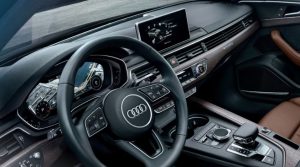
It competes most directly with models like the Mercedes-Benz E-Class and BMW 5-Series sedans but differs from them historically in that the Audi has always been a front-wheel-drive-based car that comes standard with AWD while the majority of its rivals in the segment are built on rear-drive layouts, some of them (like the Benz and BMW) offering AWD as an option.
Currently, the A6 is the only model in its class that comes standard with an electrically-enhanced drivetrain.
Both its standard four cylinder engine and its optional V6 are paired with a 48 volt electrical system that allows the gas engine to seamlessly be toggled off and on – including while the car is moving – in order to achieve the electric car boon of zero emissions of gas (while the gas engine is off) and increased gas mileage overall.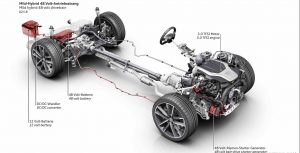
Prices start at $54,900 for the Sport Premium trim with a 2.0 liter engine and electric-assist. The next-up Premium trim is priced identically but gives you the option to buy the more powerful 3.0 liter V6, also electrically assisted. So equipped, this one stickers for $59,800.
A top-of-the-line Prestige trim with the V6 and electric assist lists for $64,500.
What’s New
The standard 2.0 liter gas engine/electric-assist combination gets a little stronger this year; total power is up to 261 (from 248 last year). Also, 19 inch wheels are standard on the base Premium trim, along with an integrated/wireless toll payment app.
A Black Optics appearance package is available. It bundles a 20-inch wheel/tire package with a sport-tuned suspension and black-themed exterior and interior trim.
What’s Good
AWD is included – and doesn’t cost you much more than it costs to buy RWD rivals like the BMW 5 and Benz E that offer AWD, at extra cost.
Gas-electric drive transitions from gas to electric drive without the herky-jerkyness of less-sophisticated engine stop/start systems in other cars.
High-tech all-digital/LCD screen dash.
What’s Not So Good
Gas mileage benefit of gas-electric system is negligible.
Traction advantage of standard AWD is offset to some degree by not much (4.2 inches) ground clearance.
Small (13.7 cubic foot) trunk.
Like others in the class, the A6 comes standard with a turbocharged four cylinder engine – to make up for a six cylinder engine no longer being standard.
As used to be the case for cars in this class.
Government pressure to squeeze ever-higher-mileage and ever-lower “emissions” of carbon dioxide (the other emissions, the ones that were issues, having been reduced to near-nil more than two decades ago) has squeezed out six cylinder engines as standard engines even in cars that cost more than $50k to start – but the people who pay $50,000-plus for a car expect more than four-cylinder power.
Hence the turbo.
The Audi’s 2.0 liter four cylinder has more than just a turbo, too.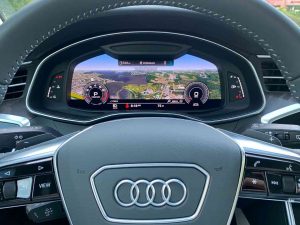
It is paired up with a 48 volt electrical system (up from the usual 12 volts) that consists of a lithium-ion battery in the trunk and high-torque belt starter/generator system up front designed to keep the gas engine off as often as possible – including while you’re moving – in order to increase gas mileage and lower C02 “emissions.”
Mercedes and other manufacturers are resorting to the same technique, not because this is what buyers want but to make it feasible to continue selling gas-engined cars in a regulatory environment bent on their elimination in favor of 100 percent electric cars – which most people do not want.
Because 100 percent electric cars impose hassle on buyers such as having to think more about and plan ahead for recharge sessions and deal with the electric car’s shorter range.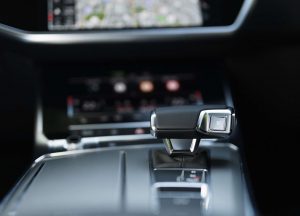
Partial electrification bridges the gap, so to speak – though it also adds to the cost, both what you pay now and what you will probably pay later. Just like any battery, the A6’s lithium-ion battery will eventually need to be replaced and that is going to cost. And replacing a lithium-ion battery is not like replacing a 12 volt starter battery.
Also, the much-increased complexity of the gas-electric driveline increases the odds of something going snafu, eventually. It is true that a majority of the people who buy cars like the A6 – i.e., high-end cars – tend to lease them or only keep them for five or six years before trading them in. So it is true they will probably not have to deal with problems such as replacing the lithium-ion battery, etc.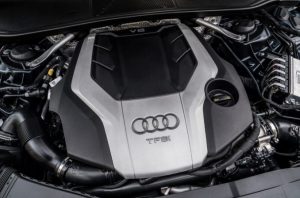
But someone will.
For now, you get more power. The 2.0 liter gas engine/electric combo summon 261 hp – up from 248 last year. It’s enough to get the A6 to 60 in about six seconds.
For more power, a six is still available. It’s also paired with the same basic electrical tandem-assist system. The 3.0 liter V6 is also turbocharged and the result is 335 horsepower.
Equipped with the V6, the A6 can get t0 60 in a very speedy 4.8 seconds – helped along by the car’s lightweight aluminum bodywork.
A seven speed automatic transmissions and all-wheel-drive are standard with both engines.
This Audi is free of what is arguably one of the most annoying – and least mentioned – features almost all new cars come standard with because the government all-but-mandates they come standard with it.
Engine stop – and start. And stop – and start. Over and over and over. At every red light, pause in the flow traffic and as soon as you park – before you’ve had a chance to turn it off yourself. Then it turns back on even though you wanted it off – because you just pressed the “start” button to turn it off because you just parked and thought it was on because you hadn’t turned it off but it actually wasn’t . . . and now it’s on again.
Engine driven accessories (like the AC) turn off and on with engine, too. Each time, accompanied by a small but noticeable shudder – and a slight delay before the car moves.
And is saves almost no gas (more on that follows).
Audi solved this manufactured-by-government problem by using a much-higher-torque belt-driven starter connected to a much more powerful battery that can spin and so restart the stopped engine nearly instantaneously and – most importantly, imperceptibly. No more drunken stagger-start-stopping or the noise accompanying the off-on cycling. You will need to watch the gauges to discern when the engine isn’t running – and when it is.
The system also enables the engine to be cut off while coasting and decelerating, without you noticing. Acceleration occurs naturally – and swiftly as this Audi is powerful with either engine.
But it’d have been easier – and much less expensive – to just leave the engine on until you decide to turn it off.
Sadly, this sort of thing is going to wax rather than wane because the edicts pertaining to gas mileage minimums and gas emissions maximums are going to wax rather than wane – until the gas engine is no more, leaving only the electric car.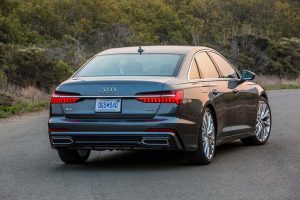
The Audi’s standard AWD system gives the A6 a traction advantage over its rear-drive (as they come) rivals from BMW and Mercedes but it’s not much of an advantage in the snow because of the car’s sport-sedan ground clearance of just 4.2 inches. This puts the A6 much closer to the pavement than the BMW 5-Series (5.7 inches of clearance) but not quite as in the weeds as the Benz E-sedan, which sits just 3.8 inches off the pavement (4.2 inches when ordered with its available 4Matic AWD system).
At The Curb
Audis have historically been the choice favored by people who want a high-end car that isn’t as obviously high-end as some of the other high-end cars.
This tradition continues.
The A6 is attractive – but not too attractive. Take off the auto union (that’s where “Audi” comes from) interlocking four circles and the A6 could pass for a Hyundai Sonata or Toyota Avalon – not that there’s anything wrong with that.
Inside, for instance.
Here you’ll find what you won’t in a Hyundai or Avalon, particularly, the entirely flatscreen Virtual Cockpit instrument cluster, which you can toggle to overlay a variety of screens, including a Google Earth View-style 3D map that’s a notch above the two-dimension displays that are used in other cars. The Virtual Cockpit is complemented – to the driver’s right – by a 10.1 inch secondary flatscreen that displays most of the other apps and functions. Touch-sensitive “haptic” feedback is part of the deal.
The car also comes standard with three-zone climate control – upgradable to four zone – a panorama sunroof and an excellent 10-speaker stereo – which can be upgraded to 16 speakers.
Massaging seats are available, too.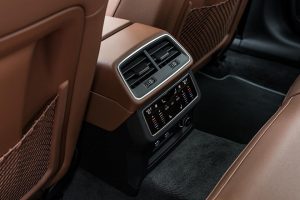
One thing you don’t get much of- and can’t order more of – is trunk space. The A6 only has 13.7 cubic feet of capacity back there (down from 14 back in 2018, pre gas-electrification) which isn’t much more capacity than in some much smaller compact-sized economy cars. The good news – relatively speaking – is that the other mid-sized cars in this class are also lacking in this department, especially the BMW 5 Series when bought with its optional gas-electric drivetrain. The battery that comes with the deal eats up a chunk of the trunk, reducing the space to just 10 cubic feet (about the same as a Mazda Miata’s trunk space) from 14. The Benz E is also trunk-shy, with just 13.1 cubic feet of room.
This lack of trunk almost certainly accounts for the declining popularity of sedans. The problem being that even the large ones don’t have much space back there – which wasn’t true of large sedans in the past. What’s happened styling-wise is that the parts of the car ahead of and behind the front and rear axle centerlines have been truncated. Hoods are no longer long – and trunks have shrunk.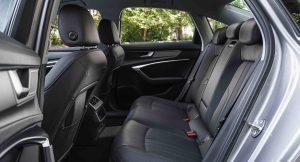
If you were to park a car like the A6 or its rivals in the class next to a ’70s-era big car, you’d be struck by how much more car there was extending past the ’70s-era big car’s A pillar (on either side of the front windshield) and beyond where the rear doors ended. These cars had trunks that complemented their size. Modern sedans generally do not – and it accounts for their waning popularity in favor of crossovers and SUVs, which create vertical space without excessive length.
Audi does crutch the situation by letting you fold down the rear seats to create a large pass-through.
But you might want to have a look at one of the other cars on the periphery of this class that still has a large trunk – and a standard V6.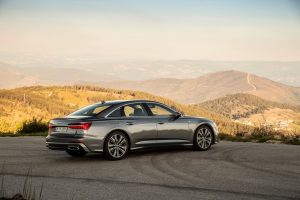
It is the Lexus ES350, which also sells for much less – $40,000 to start.
This FWD car doesn’t offer AWD – but if you don’t need it, you may be quite happy to pay $15k less for not having it.
And getting the V6, too.
The Rest
It is interesting, given the constant talking-up of saving gas, how little gas the A6’s gas-electric tag-team actually saves by keeping the gas engine off as much as possible vs. the gas mileage achieved with an almost identical gas engine that’s always on when the ignition is on.
The ’21 A6 with the 2.0 liter gas engine and 48 volt electric system rates 23 city, 31 highway. The ’18 A6, without the 48 volt electrics and the same basic 2.0 liter turbocharged four cylinder engine (making 252 hp) rated . . . wait for it . . . 22 city, 31 highway.
The real difference – the one that justifies all of this – is the reduction of gasses; the “emissions” of carbon dioxide – the regulatory cross on which the gas engine is being hung for the sin of “changing the climate.” Whether you believe in this faith or not, the penance is very real.
Expect all gas-engined cars to pay this penance, too – until it is no longer possible to atone for their sins without transubstantiating into purely electric cars.
The Bottom Line
The A6’s chief selling point vs. its primary rivals is arguably its standard AWD – vs. the optional AWD (at extra cost) in rivals like the Benz E and BMW 5 sedans. But if you don’t need AWD – and don’t want gas-electric drive, you may want to shop some of the A6’s rivals.
Especially the Lexus ES350.
. . .
Got a question about cars, Libertarian politics – or anything else? Click on the “ask Eric” link and send ’em in!
If you like what you’ve found here please consider supporting EPautos.
We depend on you to keep the wheels turning!
Our donate button is here.
If you prefer not to use PayPal, our mailing address is:
EPautos
721 Hummingbird Lane SE
Copper Hill, VA 24079
PS: Get an EPautos magnet or sticker or coaster in return for a $20 or more one-time donation or a $10 or more monthly recurring donation. (Please be sure to tell us you want a magnet or sticker or coaster – and also, provide an address, so we know where to mail the thing!)
My eBook about car buying (new and used) is also available for your favorite price – free! Click here. If that fails, email me at EPeters952@yahoo.com and I will send you a copy directly!


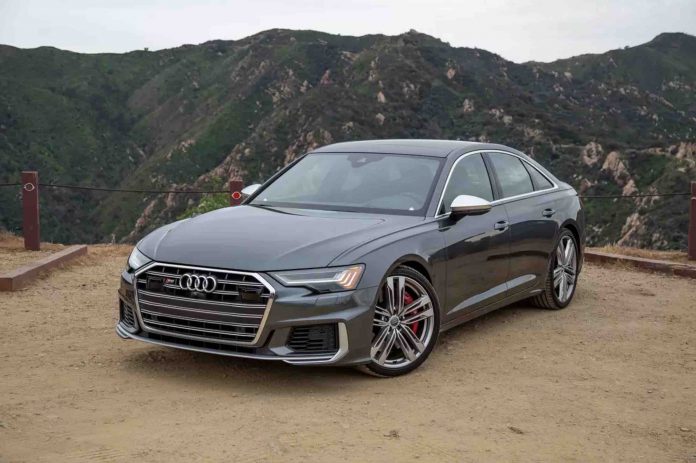




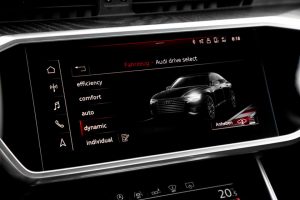







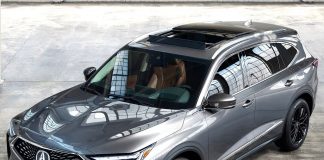
I’ve always liked the A6. Got real close to buying one for my wife to replace her E350 that had 4-5 catastrophic flats in 2 years cause of low-profile tires driving in the NE (and 2 dented rims). She couldn’t trust the car to go visit our daughter without it getting dangerous on the hell’ish route 95 in the NE. The Audi ended up with the same issue, mid and high end trims had low profiles too and the dealers would not change them to the low model tires. No sale.
I also was disappointed in Audi switching from the good blown V6 to a turbo, and now this? forgetta bout it, haha…
Hi Chris,
Amen in re the low-profile tires – which are all-but-impossible to avoid in this class. I’ve had the same issues your wife had with press cars so equipped. The roads in my area are terrible. Potholes that (per Captain Quint from Jaws) can swallow a car whole, almost. Hit one and it’s often The End of a $500 rim and the “summer” tire it’s shod with.
Audi is Woke now – and it’s basically over, as a result. Also Jaguar – which just announced it will hug the EV tar baby by 2025.
I don’t have a problem with the concept of electric motors providing final drive, and an ICE providing the electricity. Locomotives have done this for almost a century, and all submarines used this technology (with a battery buffer in between) until nuclear power took over.
ICE are most efficient at a specific RPM. In this application, they should be nothing more than a highly tuned generator that automatically starts when needed, and runs at peak performance until the battery is charged.
So far, no automaker is using that system. I wish they’d give it a try.
Hi Kevin,
The, unfortunately discontinued, Chevy Volt uses that system.
Cheers,
Jeremy
Hi Kevin,
As Jeremy mentioned, Chevy used this system to create the Volt – the only practical electric car ever offered for sale. But it committed the sin of being practical – no range anxiety, the same time to refuel as any other car. This had to be stomped – and was, via the excuse that the Volt wasn’t truly an EV because it still had an IC engine (to power up the batteries). Which of course is true, but the implication that this was any kind of “environmental” problem is utter nonsense as the tiny IC engine “emitted” hardly anything and certainly nothing sufficient to affect “air quality” or affect the “climate.”
It is easier to purchase the same tiguan.
https://www.ericpetersautos.com/2021/02/03/2021-vw-tiguan/
Good characteristics, I think you can consider it as a replacement for the old car, but it all depends on your meta-survival and the availability of charging stations.
Sounds like a new way to spell “endless money pit”.
If you have an electric vehicle and live in Texas, you won’t be able to charge the battery today. Good thing there is global warming, otherwise Dallas would be even colder than the 4 above they have this morning with 2-4 inches of snow in the forecast.
Not much fun when there is no electricity.
When we say it is warming, it is warming said the warmunist lysenko-ists. lol
I wouldn’t be able to sleep at night with a Tesla parked in the garage and a 350 volt battery pack in the thing.
Warmunist humor: Texas is proof that if you assemble enough Californians in one place, rolling blackouts will occur.
This electric Rube Goldberg device is a lot like the covid vaccine. A lot of resources were expended for little to no benefit, with the lurking possibility of serious negative consequences in the future.
Imagine the efficiencies that would be obtained if markets were truly free.
‘Imagine the efficiencies that would be obtained if markets were truly free.’ — Mr Liberty
Monopoly electric utilities are the antithesis of free markets. Unlike the relatively decentralized distribution of fossil fuels such as gasoline, diesel and propane, when the electric grid goes down, it fails catastrophically (cf. NYC 1965; NYC 1977; Texas 2021).
The grid needs a total rethink, along the lines of the internet (many decentralized, redundant nodes with self-healing alternative routing). Swamping a broken grid with EVs only accelerates its collapse.
Pull the plug on Washington, DC: nullify fedgov ‘laws’ — not just already-dead cannabis prohibition, but gun grabs and gas mileage mandates too.
Willy, he tells me that doers and thinkers
Say moving’s the closest thing to being free
— Billy Joe Shaver, ‘Willy the Wandering Gypsy and Me’
Freedom’s Child by Billy Joe Shaver is an all-time favorite.